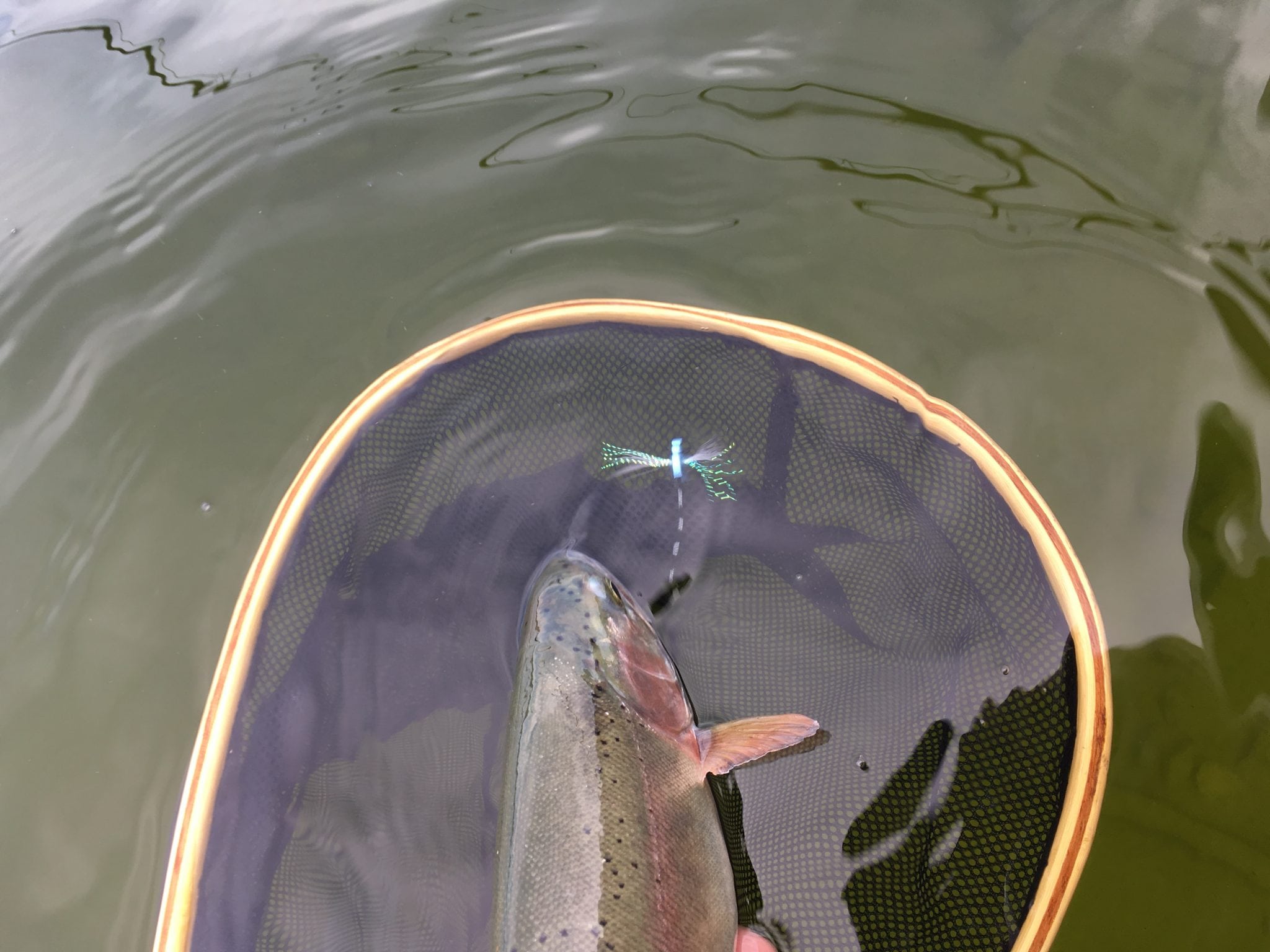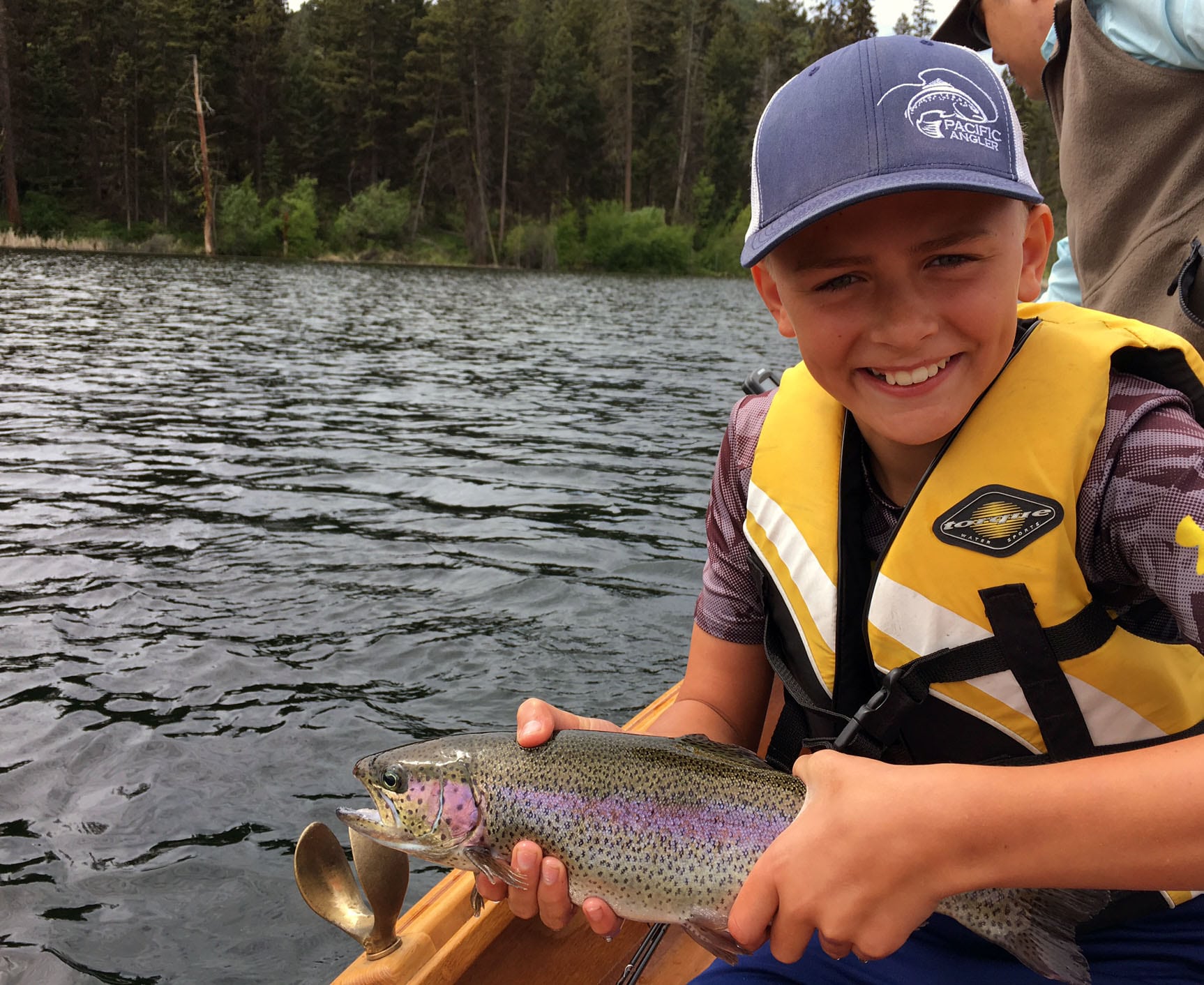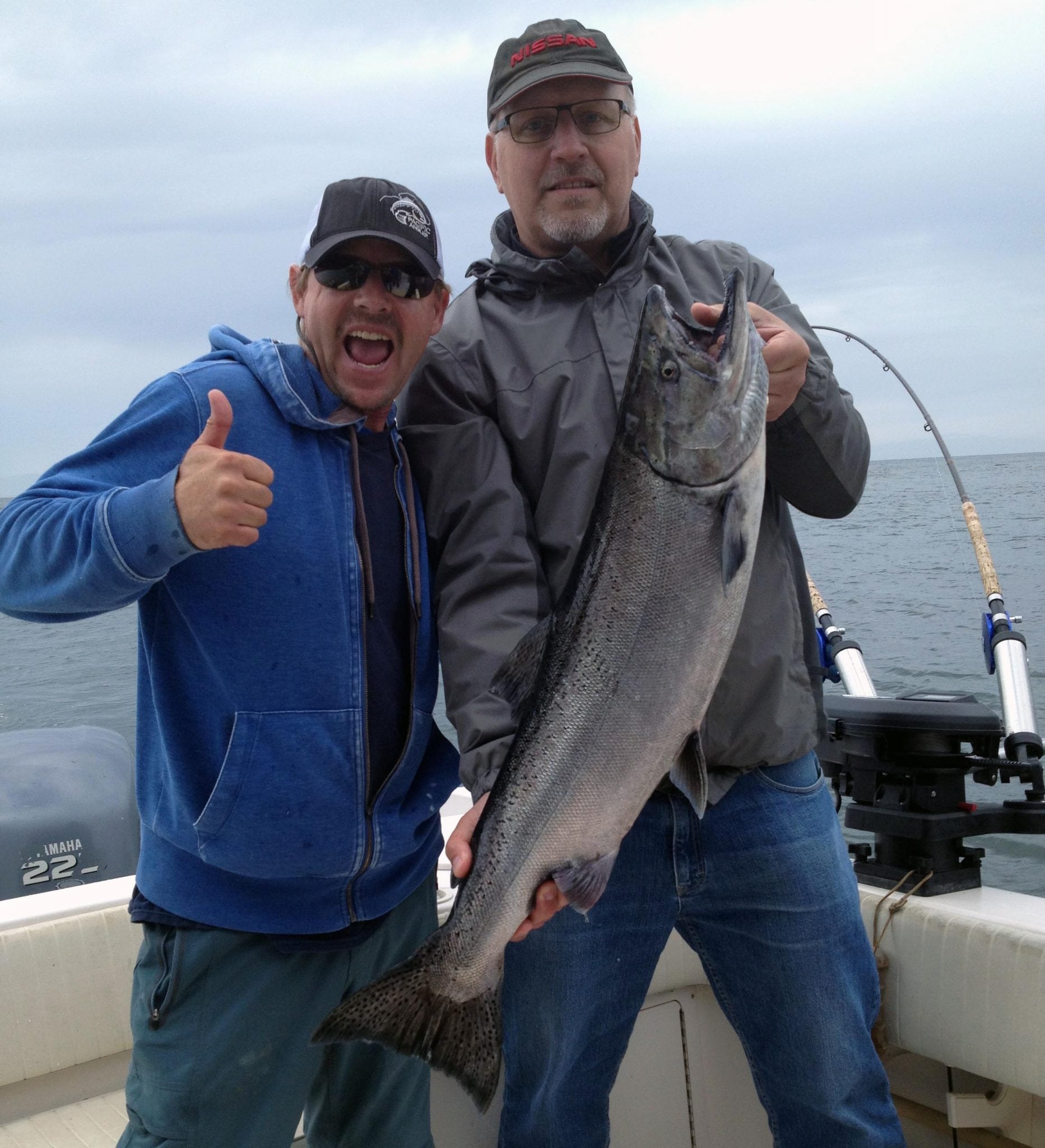OUTLOOK
The past month has brought with it a mixed bag of weather. We have had to fight wind on the saltwater scene and there have been a few wet cold weekends for lake fisherman, however looking at the last month as a whole, we have been lucky. It has rained when we needed it to keep river levels healthy. It has been cool when we needed it to keep lake temps down and we have also had some great hot weather to get the hatches going allowing all of us a little sun therapy on the lakes, on the ocean or out on a patio around town.
This trend is going to continue this week. We have some rain in the forecast and slightly cooler temps both in Vancouver and up in Lake country. This may not be ideal for spending time out on the water but when looking at the entire season it is good news for the next couple weeks. For guys planning some fishing this weekend don’t worry. You may not be lathering on the sunscreen but if the weather man is correct the rain and slightly colder weather will not be anything a Vancouverite can’t handle.
On the lake front, the cooler temps, wind and cloud might encourage may fly, damsel and sedge hatches if the moving barometer and wind does not mess things up. With this in mind, Andre has done another awesome report on fishing strategies related to sedge hatches. Check it out in the lake section below.
On the saltwater front we had a pod of orcas move through Howe Sound earlier in the week. The whale watching was awesome but it put a major damper on the fishing. For guys heading out tomorrow don’t worry. The reports yesterday picked up again and the whales are gone. Check out the saltwater report for more details.
For the river fisherman, the Capilano is starting to pick up and we are hearing that guys are catching the small early coho with some consistency. It is still too early for beach fishing but depending on water levels it could be soon. With this in mind we have Andre’s beach fly tying course coming up at the end of the month and there are still spot available. Call if you are interested and check out more details in the course section below.
Our other river systems are mostly still closed or too high to fish effectively. With good weather this month we could have a good river season when things open up and drop into shape. Check out the river section of the report for more details.
UPCOMING COURSES
Introduction To Fly Fishing Trout Streams
This course is comprised of one 3 hr evening seminar where we go over everything you need to understand the different flies and techniques for tackling classic river trout fishing.
Dates: June 21
Cost: $45.00
Tying Beach Fly Patterns
Join Pacific Angler for a 3hr evening seminar of tying flies specific to catching salmon on our coastal beaches. Without a doubt, fly selection is critical while beach fishing.
These flies are often not commercially available, so successful beach anglers learn to tie their own patterns. Your instructor will walk you through each fly pattern step-by-step.
This Tying Beach Fly Patterns course is suitable for fly tiers with a basic knowledge. Students are required to supply their own vise, tools and materials. A 10% discount is available on fly tying materials and tools purchased for the course.
Dates: Jun 20
Cost: $45.00
Time: 6:30pm – 9:30pm

ON TO THE REPORT!
Chilliwack River
The next fishery on the Chilliwack system will be red springs starting July 1st.
Capilano River Fishing Report
The water level of the Capilano River has been good for both fishing and fresh fish entering the system. While fishing has been relatively slow recently; some coho salmon have been caught on both gear and fly tactics. With the river flowing well and more rain in the forecast; we should see some good local salmon fishing over the next month. Short floating a variety of natural baits such roe, krill, and dew worms is effective when there is enough current in the pools to move your float. When the river level drops, casting and retrieving small spinners and spoons is a more effective presentation than float fishing. Fly fishing is a deadly way to target coho salmon, particularly in the deep canyon pools. A 6 to 8 weight fly rod matched up with a type 6 sinking line allows you to steadily retrieve your fly through the right column of the water. Effective fly patterns for Capilano coho include small olive coloured flies; such as Andre’s Cap Bugger, olive or blue muddler minnows, and even small flashabou flies.
You may catch the odd summer run steelhead in the Capilano. These fish are extremely low in number and must be handled and released with the utmost care. There is zero retention of steelhead (both hatchery and wild) in the Capilano River. If you don’t know what it is, don’t kill it!
Please note: ALL steelhead(adipose clipped and unclipped) must be released with the utmost care.
Chehalis River
The Chehalis River was closed for May allowing winter run steelhead a break from the pressure and a chance to spawn. It opened on June 1. This system is fun if you like hiking and is a great float fishing river. Summer run steelhead should be showing up soon. We have had a few reports from this direction and it could be a good bet if we get some rain.
Interior Lakes
The heat came on strong last week after unsettled weather pushed through. The water temperature rose from 55-57 to 63-65 degrees on lakes in the 3600 to 4000 foot range. This turned off the chironomids and brought on different hatches. Although there were still chronomides hatching, damsels, mayflies and caddis took the interest of the trout. As the wind died down, trout were gorging on adult damsels on the surface (see pic) and later in the day, caddis took over. The temperature has dropped again this week so make sure to be ready to go back to chironomids just in case the water temps cool down.
Below is a description on how to fish caddis pupa:
Pupal Fishing Tactics
When we look at the life cycle of the traveling sedge, the pupal stage, when they swim and emerge, and the egg laying adult stage are what trout key in on. While most anglers eagerly anticipate the adult stage for dry fly fishing, the pupal stage attracts the majority of attention from the trout. Feeding on the sedge pupa below the surface is much safer than surface feeding when it comes to avoiding the common predators of trout which include ospreys and loons.
Traveling Sedge pupae swim on a shallow angle upward to the surface of the lake. Trout can intercept these large food items at any depth, but often prefer to do so closer to the lake bottom than the surface. It is always wise to first present pupal patterns near the bottom of the shoal and gradually work up through the depth zones. Floating and slow sinking lines are ideal for imitating the “pupal swim”. The key to successfully fishing the pupa is to ensure your pattern is right on the lake bottom before initiating a retrieve. Floating lines are perfect for fishing water up to about 16 feet in depth. Use a leader at least 25‰ longer than the depth being fished to ensure the fly can reach the bottom. In deeper water switch to a slow or intermediate sinking line and use a countdown method to make sure the fly reaches the bottom before starting the retrieve. A quick 4-8 inch long strip retrieve interspersed with regular pauses is a good match to the real movement of this insect life stage. You will quickly find out the preferred feeding depth which often will be a 2-3 feet wide zone in water that could be 12-20 feet in overall depth. Using the floating line and long leader technique makes it possible for the fly to stay in a relatively narrow depth zone while retrieved horizontally through the water column. This is achieved by first allowing the fly to sink to the desired depth and then making several quick strips and then pausing long enough for the fly to sink back down. This is an important technique to learn as it is an effective presentation for many other stillwater trout food sources. Use the same strip retrieve when using the slow or intermediate sinking line. Make sure to allow the pupal pattern to first sink to the desired depth before initiating the retrieve.
Come down to the shop and we can show you the flies you need and go over the set up! GOOD LUCK!
VANCOUVER SALTWATER FISHING REPORT
Well you know it is starting to get warm out when the NW winds show up! Just like last year, the NW winds have often gotten in the way of the run across the pond to Gabriola and Nanaimo. Those that have been across have had some good fishing, but for the most part this past week was average at best. This will often change when the winds die down and more anglers get over and the fleet gets a bead on where the fish are. By no means is it time to not be heading over. June is often the best month at Thrasher so if you are heading over on your own or you want to book a trip now is the time to go.
Hot depths have been 130-220 on the riggers. 130-175 seems to be good if you are fishing offshore more, and if you are fishing inshore and see bait on the bottom, that is where you want to hang some gear. White UV hootchies have been good, as well as the chartreuse splatter back. Spoons have also been productive, like the Pesca 3.5 in Gut Bomb, the Kingfisher 3.5 in Flaming Hans, and the Titan 4.0 in Mojito or Vegas. The most productive flasher has been the Salty Dawg and if you are fishing way down deep like 200 to 240 then the Double Glow has been very good.
On this side of the pond we have also had a lot of wind. There are still lots of anchovies moving around in the southern sections of Howe Sound and it has made for some fun and productive fishing for chinook and coho. The best part is the fish are shallow. 30 to 80 on the riggers has been good. If you find the birds, you find the anchovies, and then you find the chinook. The same spoons mentioned above have been producing well. For flashers the Salty Dawg, Green Onion Glow, and Purple Onion Glow have been working well. The Silver Betsy and Gold Betsy have also been very productive on the shallower rods. We are fishing so shallow we are running flashers like the Besty as we don’t really need glow tape 30 or 40 feet down. It’s been awhile since I said we don’t need glow! There are lots of coho around as well. Try running a white UV hootchy on your top rod and you will do well. Remember you can only keep hatchery coho. If you want to run bait, that has been working well along with the spoons and hootchies. 5.25 and 5.5 inch anchovies are deadly and we have lots in stock. We have been using chrome teaser heads on our top rods and glow teaser heads on our bottom rods.
We have boats out all weekend and we should have more info early next week so as always don’t hesitate to call in and ask for and update or even better call in your report if something interesting happens out there. 604-872-2204. If you want to book a trip call NOW to get a spot! 778- 788-8582
GOOD LUCK!!








